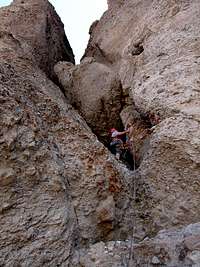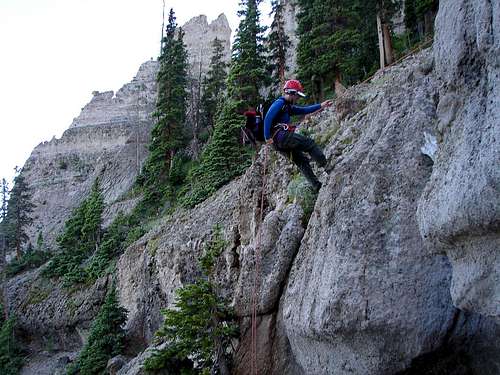-
 9060 Hits
9060 Hits
-
 85.87% Score
85.87% Score
-
 21 Votes
21 Votes
|
|
Route |
|---|---|
|
|
38.14668°N / 107.57067°W |
|
|
Trad Climbing |
|
|
Summer |
|
|
A long day |
|
|
5.6 (YDS) |
|
|
5 |
|
|
III |
|
|
Overview
Chimney Rock is not for the faint of heart. It's name is an apt description of one of Colorado's most difficult summits by its standard route. A large crack on the south face running almost to the summit makes for a four-pitch 5.6 rock climb, but don't be fooled, the route is loose, runout, hard to protect, and dangerous. This route is for only one party of two. Any more and rockfall and time become serious issues. Good weather is a must. Afternoon storms could turn this route into a nightmare.The Approach
See the main page for instructions on how to get to the trailhead.Hike up the Jeep road for one mile. Originally, it appears that this road could have been driven, but now it is blocked by a huge boulder. Near the end of the Jeep road, begin looking for a wide, but low-stacked cairn next to the road on the right. At the cairn, turn right (NW) on what looks like a trail, but soon peters out to nothing. Bushwhack northwest through the woods. Animal trails are sometimes available, but mostly it is a relentless slog through the down-fall and vegetation. After about 200 yards, the grade steepens considerably. Head directly uphill and toward Chimney Rock. As you gain the ramparts directly below the cliffs, you will be greeted by two small amphitheaters on the left and right. Look for rap slings at the top of the left (south) amphitheater. This is your descent route. However, this is the incorrect amphitheater for the ascent. The left amphitheater is a loose, and unprotectable class 4/5 mess. Instead, ascend the right (north) amphitheater, exiting to the left. At the top of the right amphitheater, exit left to a short class 4 section, then gain easier terrain to the final ridge. Angle up and right toward the edge of the ridge then traverse to the right (east) to the base of the route.
The South Crack
Pitch 1: The first pitch begins with a fairly easy overhang (5.6) on conglomerate rock. After the overhang you find yourself in a bowl with an option to go either right or left. Going right will keep you at 5.6. Be careful here as the rock is loose. You will also want to make your first placement as a fall here will plummet you down past the overhang and will most assuredly be very bad.Your best bet is to climb briefly up the left facing crack, then ease out to your right onto a ledge by the right crack, then swing around and climb up onto the face to the right of the right crack. After a short exposed climb, you will then encounter easy climbing up to the first belay station. Here you will find some old slings from previous climbs.
Pitch 2: The second pitch starts off with easy scrambling, then you will climb back up onto some more 5.6 near the crack, then up and into a small cave of sorts. Placements are limited but you will find one before you start some more 5.6 climbing up under a roof and out on to some near vertical very hard to protect rock. Climb to your right out onto a very airy face. I found a horizontal crack facing away from me on the roof for a small cam that I had to blindly place since it was facing away from me. Who knows it will hold, but at least it will give a little comfort as you climb up onto the face. Check each hold as a fall here would be bad. This will be the most runout pitch on the climb. I was able to find another cam placement after coming out from under the roof. From there on up the climbing eases up but placements are almost non-existent. I went ahead and climbed on up to belay station #2 at this point over a small overhang. I added a cam in a high crack so we wouldn't have to rely on only the slings for protection. There is one bolt (the only one I saw on the entire climb) but it is pathetic and can't be trusted.
Pitch 3: The 3rd pitch starts off with easy scrambling, with the exception of snow which will remain into July. It will be hard to avoid getting your shoes wet as the crack is too wide at this point to straddle the snow. After the snow you will be back onto some more mid 5 climbing in the crack. You will soon find belay station #3. When I passed by the old slings were frozen in ice and were useless to us. If this is the same for you, climb on up past the belay station if you have at least a 180 ft. rope.
You will now encounter the crack running up into an unprotectable overhang. To avoid this, climb out to the left onto an almost vertical face (5.6) with plenty of handholds but difficult to protect. If you look long and hard, you will find one place for a small cam on the wall amidst the conglomerate rock. I would highly recommend finding a placement as a fall here would be bad. Climb up on this 5.6 rock, then traverse over to the right and on top of the overhang along small ledges. Scramble up a bit on easier climbing and set up a belay station. This will be no easy task as placements are few and far between. The crack is wide and quite dirty. I tried using a #4 cam but there was too much dirt in the crack. I ended up using a sling over a very small chicken head, a poorly placed cam, and a sling around a semi-loose rock. This was the best I could find.
Pitch 4: If you climbed past belay station 3 like I did, the next pitch will be quite short and the easiest of the climbing. It's fairly straight forward up the crack to a rock which will have two 11 mm static ropes around it, probably placed there by the San Juan Mountain Guides.
Pitch 5: From pitch 4, scramble up to the right to the very top of the gully. Scramble over easy almost level terrain to a 4 ft. wide gully that is probably around 25 feet deep that blocks you from the actual summit. It would be advisable to rope up as the move over this gully is easy but any fall would be very bad. After crossing the gully, it's an easy scramble past the 5th belay station and then another 50 feet to the actual summit.
Descent
Rappel your route on the tower. Three raps seemed to work well to avoid the rope being hung up. From the summit, do a 200 foot double-rope rappel past the third belay station and ending about 30 feet from the 2nd belay station (top of pitch 2). Scramble down 30 feet to the second belay station. From the 2nd belay station, do a single rope rappel to the first belay station (top of pitch one). From there, do a final single-rope rappel to the base. Although a double-rope rappel is possible from the top of pitch two, it is better to do two single-rope rappels to avoid the knot in the double rope from being caught in cracks on the route.
From the base, reverse your approach route to the top of the short class 4 section above the amphitheaters. At the top of the south amphitheater, you will see several rap stations, built on a large chickenhead or around trees. Either down-climb the short class 4 section or do a rap to the top of the amphitheaters. From the top, do a 150 foot double-rope rappel to the base of the south amphitheater. Descend the ramparts, and head directly southeast to intersect the Jeep road.
From the base, reverse your approach route to the top of the short class 4 section above the amphitheaters. At the top of the south amphitheater, you will see several rap stations, built on a large chickenhead or around trees. Either down-climb the short class 4 section or do a rap to the top of the amphitheaters. From the top, do a 150 foot double-rope rappel to the base of the south amphitheater. Descend the ramparts, and head directly southeast to intersect the Jeep road.
PrecautionsThis route is loose, runout, and dangerous. Only a party of of two is recommended due to extreme rockfall. Wear helmets and be prepared for some pretty runout stuff only for the experienced trad climber comfortable with exposure. Expect at least one section of 30 to 50 ft. runout 5.6 climbing. Test all holds, especially when you are far above your last placement. An early start and perfect weather is a must.
Essential Gear
Two 60 meter ropes. You can expect to use 7 to 10 cams on the longest pitch. Most of the cams you will need will be from the 1 to 4 range. Bring some long runners to avoid rope drag and bring at least six 9 ft. long sections of webbing for rappels along with at least a half-dozen rap rings. You won't find much use for hexes or nuts.If anyone retrieves a red Camalot (#1) from deep in a crack on one of the middle pitches, it belongs to Alan Ellis. Contact him via his profile to return it to him. Thank you.




